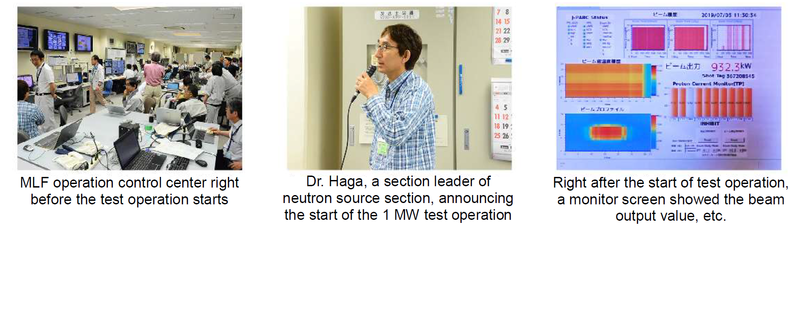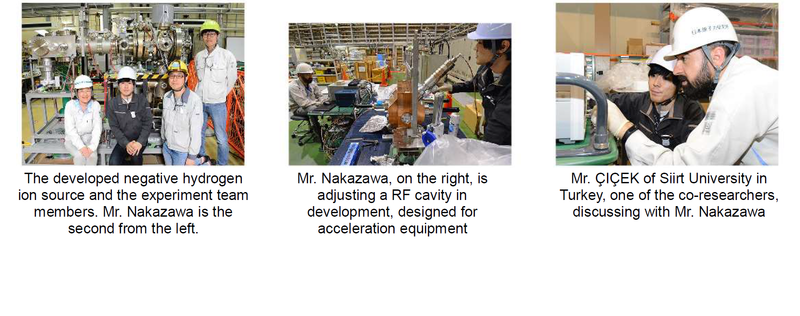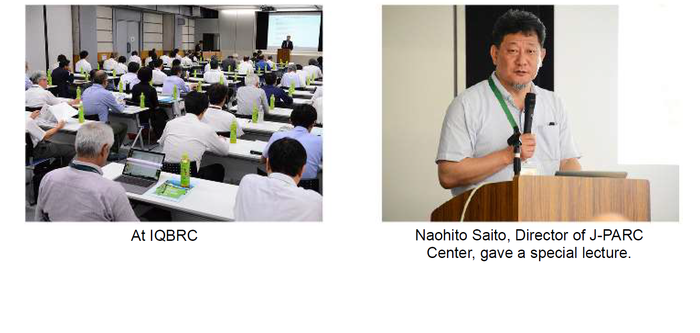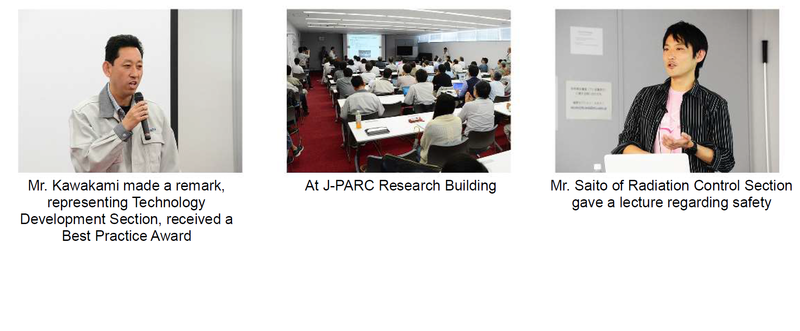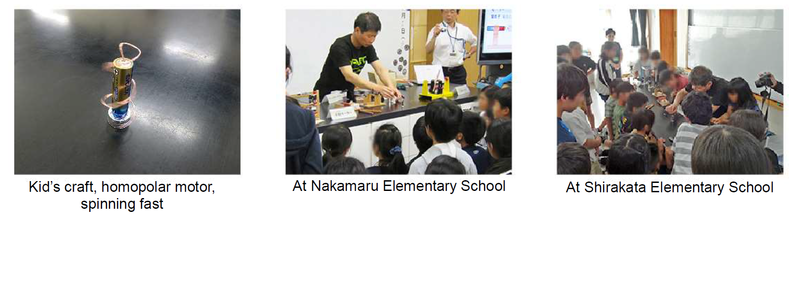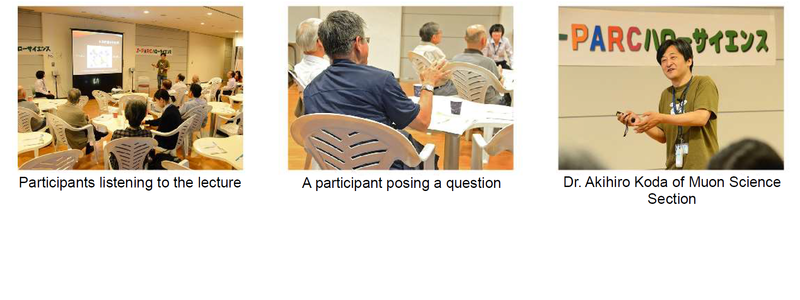J-PARC NEWS June 2019 (Issue #170)
■ MLF Performed 10.5 Hours of Continuous Test Operation with Beam Intensity of 1 MW (July 3)
On July 3, 2019, the Materials and Life Science Experimental Facility (MLF) successfully performed 10.5 hours of continuous test operation to generate a proton beam equivalent to 1 MW as a beam intensity goal of MLF, and accomplished stable beam generation with an operation rate exceeding 99%, subsequent to the stable operation at 1 MW achieved on July 3 last year. The target vessel is a container with improved durability and reliability by reducing welding points substantially, which MLF has been using since October last year. Aiming to raise the output in stages from the current practical use output of 500 kW, MLF will continue to gather and analyze detailed data while ensuring safe and stable operation.
■ Mr. Yuga Nakazawa Developed Negative Hydrogen Ion Source, Leading to Success in Negative Muonium Ion Acceleration Experiment (June 11, featured on the Japanese-version J-PARC website)
A research group studying the characteristics of the elementary particle muon has been engaging in experiments to generate a high-energy and high-quality muon beam necessary for the precise measurement of the muon anomalous magnetic moment (g-2) and electric dipole moment (EDM). Recently, the group successfully developed a new negative hydrogen ion source to adjust an equipment for accelerating the muon. This result was achieved by Mr. Nakazawa, a postgraduate student of Ibaraki University who was working at J-PARC as a KEK Research Fellow. The developed ion source is useful for adjusting the magnetic field applied to the muon after its acceleration, as well as for decelerating the muon. The muons generated by a J-PARC accelerator have various directions and momentums. To obtain a high-quality muon beam with each muon aligned in direction and momentum, the generated muon beam is decelerated to produce muoniums, the muoniums are ionized to obtain ultra-slow muons, then the ultra-slow muons are reaccelerated. After that, a magnetic field is applied to the reaccelerated muon beam to take out the muons with desirable momentum. However, the adjustment of the magnetic field takes quite a bit of time. The developed ion source device produces negative hydrogen ions when an ultraviolet light is irradiated onto an aluminum plate target. The produced negative hydrogen ions can easily reach the same momentum as that of the accelerated negative muonium (Mu-), which means the magnetic field can be adjusted prior to experiment and make it possible to perform experiments within the limited experiment time allocated for using the J-PARC accelerator. In this test operation, the target of the developed ion source device was replaced with a target made of kapton and aluminum, and the generated Mu- were successfully accelerated by injecting and decelerating a muon beam from the J-PARC accelerator. To obtain a muon beam with the necessary energy for the muon g-2 and EDM measurements requires three more stages of acceleration. Mr. Nakazawa is currently working on the development of a device for the second-stage acceleration. Furthermore, instead of using the Mu- that were successfully accelerated this time, if the ultra-slow muons obtained through the ionization of muoniums can be accelerated, the efficiency and brightness of the muon beam will increase. That is important, because the high-intensity/quality muon beams are key to the precise measurement of g-2 and EDM, where g-2 is a physical quantity of the magnetic intensity of the muon, and the result at an overseas experiment indicates that the muon g-2 has a discrepancy between measurement and prediction by the standard theory of elementary particles. The experiment led by Mr. Nakazawa may result in a discovery of new physics beyond the standard theory. For more details, please click here. https://doi.org/10.1016/j.nima.2019.05.043
■ Naohito Saito, Director of J-PARC Center, Gives Special Lecture on “Accelerating the Future by J-PARC” at General Meeting of Prefectural Neutron Use Liaison Committee (June 20, IQBRC)
Ibaraki Prefecture has established the Prefectural Neutron Use Liaison Committee for the purpose of promoting the use of neutrons, mainly the prefectural beam line built at MLF. Recently, a general meeting of the Committee was held at the Ibaraki Quantum Beam Research Center (IQBRC). Many representatives from member companies and other organizations attended the meeting, and the staff of the Committee reported on the current status of industrial use of neutrons, relevant initiatives by the prefecture, and the examples of neutron use at J-PARC. At the meeting, Naohito Saito, the Director of the J-PARC Center, delivered a special lecture titled “Accelerating the Future by J-PARC,” explaining the state of neutron-related activities in detail, such as scientific research conducted at J-PARC and achievements of industrial use of neutrons.
■ J-PARC Safety Day (May 24, J-PARC) On May 24, the J-PARC Center held a Safety Day to remember the accident of radioactive material leak at the Hadron Experimental Facility that occurred on May 23, 2013, and to “Raise the Safety Awareness of Staff.”
(1) Safety information exchange meeting held (J-PARC Research Building) At the information exchange meeting, first, the Director of J-PARC Center presented the Best Practice Award, Creativity Award, and Sanitation Consideration Award to groups that exhibited excellent performance in safety initiatives at workplaces in the previous financial year. In the following Science Talk on Safety, Mr. Fumihiro Saito of the Radiation Control Section gave a presentation on the “Results of Study on Fast and Simple Radiation Dose Estimation Method in Preparation for Accidental Exposure.” Then, as examples of safety work at workplaces, some staffs reported on the heavy load transfer work from MLF inside and the safety measures when using a temporary electric generator at the Information System Section. Information about safety was thus shared inside the J-PARC.
(2) Conference for developing a safety culture This year, Dr. Yayoi Nagai (representative of Office KAZE NO MICHI, former Director of Medical Quality and Safety Management Center, Gunma University Hospital) was invited to give a lecture titled “The Power of HUMAN Needed for Strong and Safe Organization.” Medical practice involves numerous communications among physicians, medical staff, and patients. Based on her experiences as director of the safety management department of a hospital, Dr. Nagai provided invaluable information on the importance of communication and measures against assumptions and prejudices on safety assurance. Then, a video on the radioactive material leakage accident that occurred six years ago was screened. This was followed by a talk given by Dr. Tetsuro Ishii, the Deputy Director of Safety at J-PARC, titled “Starting Point of Concept of Safety,” covering topics like “Do not get injured, do not allow injury,” which concluded the training session.
■ Safety and Health Liaison Meeting with J-PARC Contractors (June 26, J-PARC)
The operation of J-PARC facilities and maintenance of facilities and equipment involve many contractors. Prior to the summer maintenance that starts in July, on June 26, J-PARC held the Safety and Health Liaison Meeting with J-PARC Contractors to share safety awareness among the contractors and J-PARC staff members for ensuring safety. This year, 71 participants from 65 companies and 17 participants related to J-PARC took part in the meeting.
■ J-PARC Scientific Experiment Class (June 12: Tokai Village Nakamaru Elementary School, June 13: Tokai Village Shirakata Elementary School)
On the 12th and 13th of June, as a part of J-PARC Hello Science activities, scientific experiment classes were held at two elementary schools in Tokai Village. At the classes, pupils intently watched a demonstration of the world’s first motor (Faraday motor), a manual motor in which a coil is rotated by switching the direction of electric current running through the coil of an electromagnet, and a dry cell dashing through a copper wire coil. Then, pupils worked on making a homopolar motor using a magnet, aluminum foil, dry cell, and copper wire, in which the copper wire is rotated by the act of magnetic force produced by electric current running through the copper and the magnetic field of the magnet. After having a hard time bending a copper wire properly, they cheered and applauded when the coil successfully rotated.
■ J-PARC Hello Science “Probe Materials Using Muon!” (May 31, Tokai-mura Industry and Information Plaza “iVil”)
At a Science Café in May, Dr. Akihiro Koda gave a lecture on the muon. The lecture started with basic information about the muon that allows examining the inside of materials at the atomic level, similar to neutrons, followed by explanations on muon spin rotation/relaxation/resonance (μSR) measurement, which is a material research technique utilizing the spin-polarized nature of muon at the time of its generation. As an example of recent research achievements, Dr. Koda then talked about how the muon helped in understanding why milling MgH2 encourages the release of hydrogen from it. (The MgH2 is one of the promising hydrogen storage materials used for hydrogen vehicle, etc., which was featured in the previous issue.) The session proceeded in a friendly atmosphere with Dr. Koda occasionally responding to questions from the audience.

